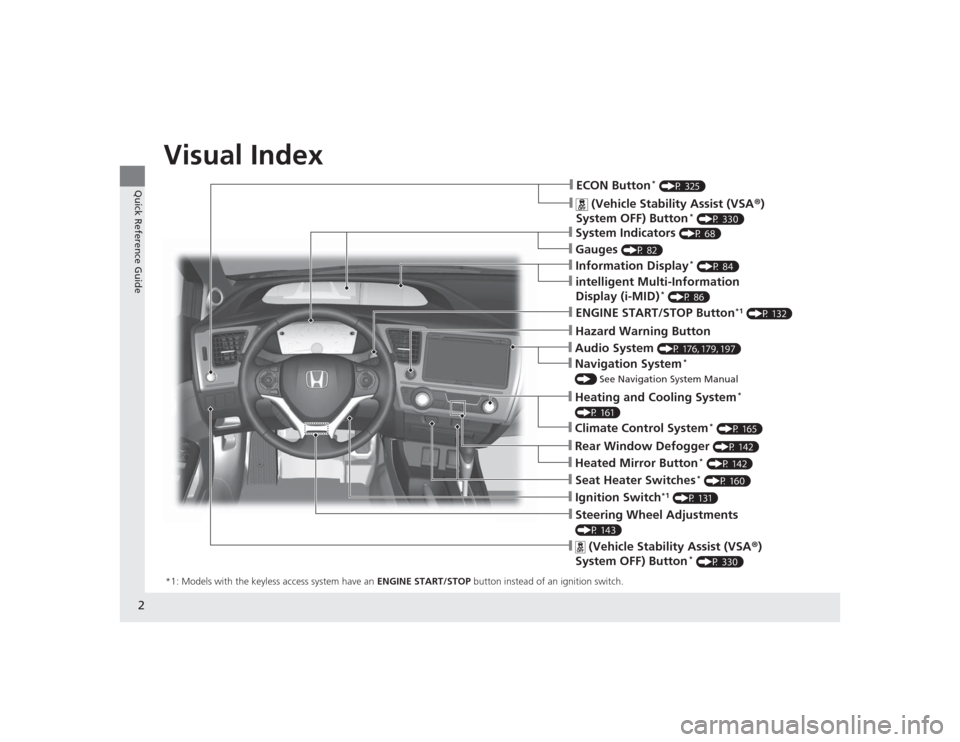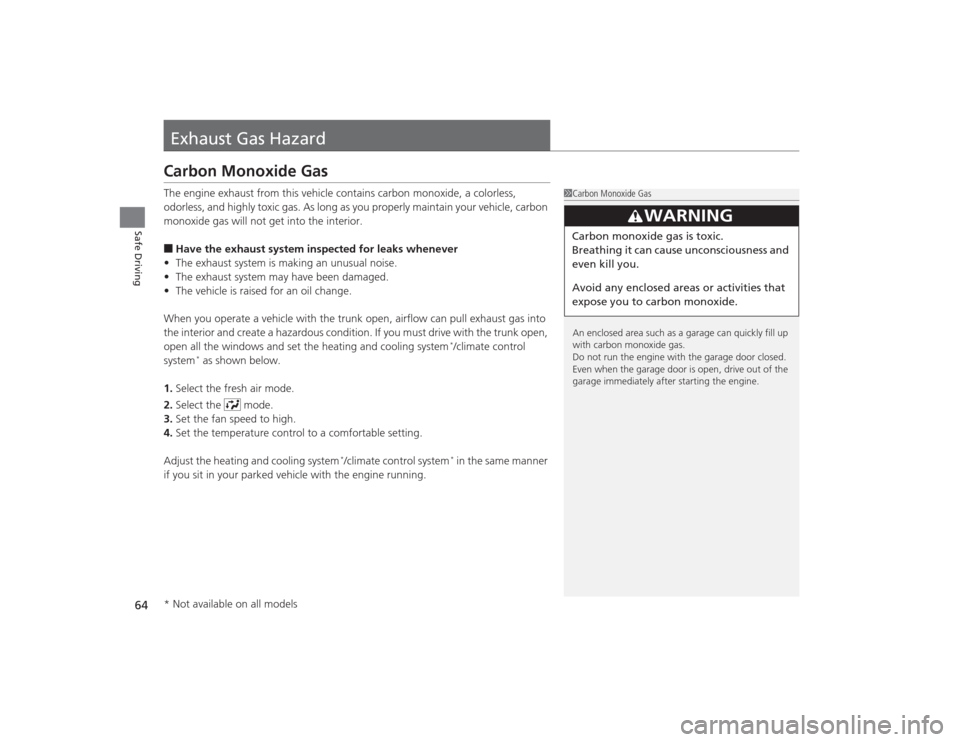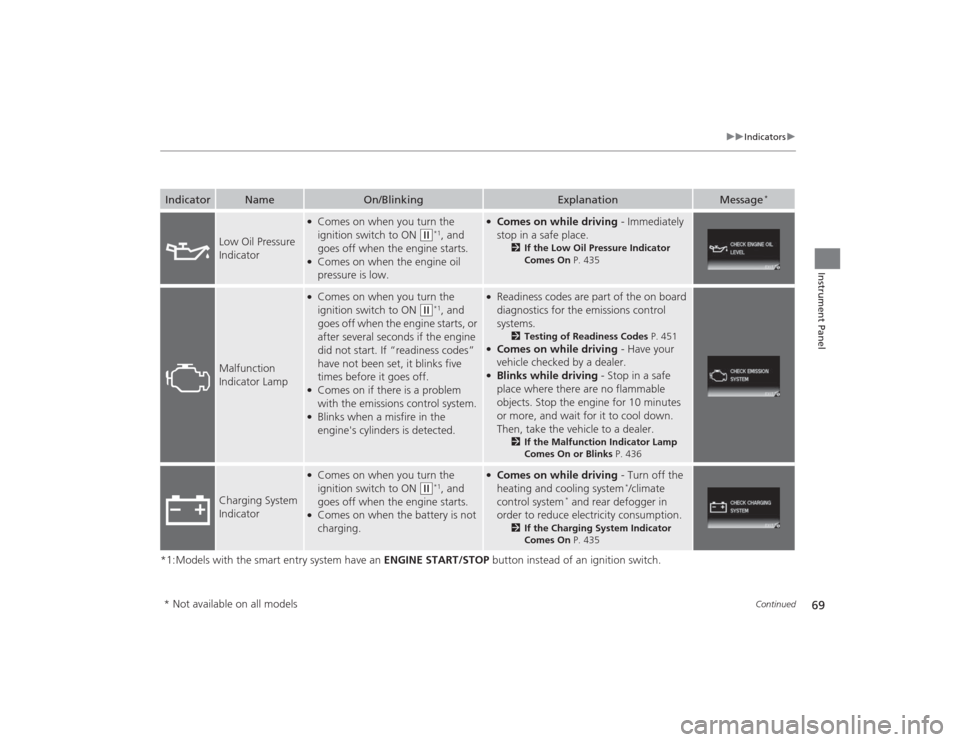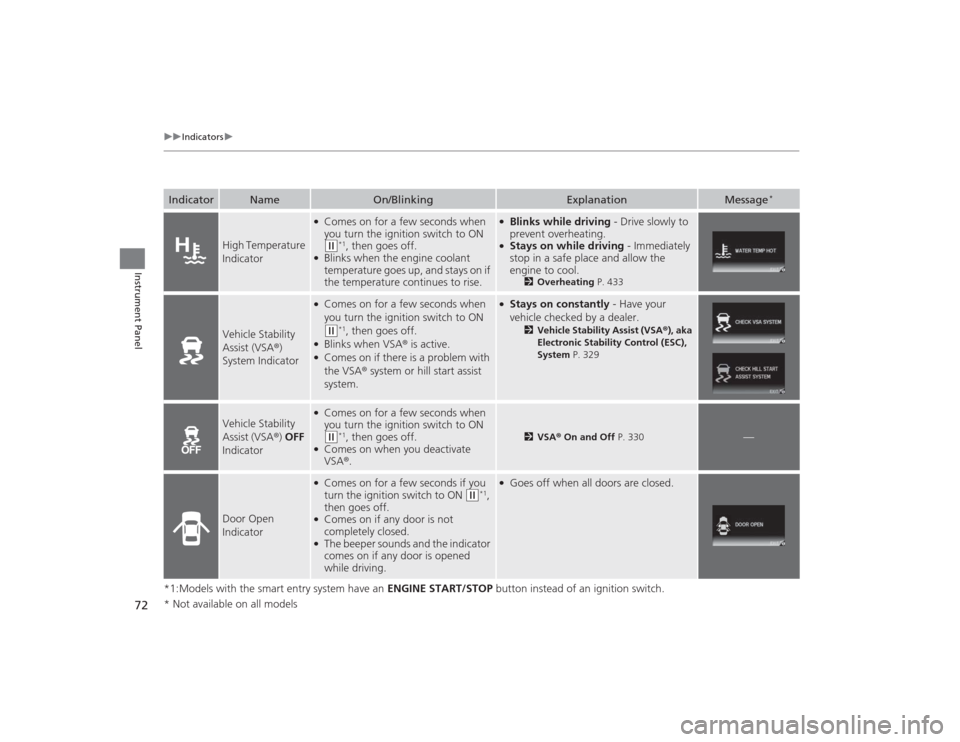2014 HONDA CIVIC heating
[x] Cancel search: heatingPage 1 of 469

ContentsThis owner’s manual should be considered a permanent part of the
vehicle and should remain with the vehicle when it is sold.
This owner’s manual covers all models of your vehicle. You may find
descriptions of equipment and features that are not on your
particular model.
Images throughout this owner’s manual (including the front cover)
represent features and equipment that are available on some, but
not all, models. Your particular model may not have some of these
features.
This owner’s manual is for vehicles sold in the United States and
Canada.
The information and specifications included in this publication were
in effect at the time of approval for printing. Honda Motor Co., Ltd.
reserves the right, however, to discontinue or change specifications
or design at any time without notice and without incurring any
obligation.
2Safe Driving P. 27For Safe Driving P. 28 Seat Belts P. 32 Airbags P. 392Instrument Panel P. 67Indicators P. 68 Gauges and Displays P. 822Controls P. 103Clock P. 104 Locking and Unlocking the Doors P. 106
Opening and Closing the Moonroof
* P. 130
Adjusting the Seats P. 146
Climate Control System
* P. 165
2 Features P. 169Audio System P. 170 Audio System Basic Operation P. 176, 179, 197
Customized Features
* P. 233 Bluetooth® HandsFreeLink ®
* P. 246, 277
2Driving P. 303Before Driving P. 304 Towing a Trailer P. 309
Rearview Camera
* P. 342 Refueling P. 343 Fuel Economy P. 346
2Maintenance P. 349Before Performing Maintenance P. 350 Maintenance Minder
TM P. 353
Checking and Maintaining Wiper Blades P. 389
Heating and Cooling System
*/Climate Control System
* Maintenance P. 403
2 Handling the Unexpected P. 409Tools P. 410 If a Tire Goes Flat P. 411
Overheating P. 433 Indicator, Coming On/Blinking P. 4352Information P. 443Specifications P. 444 Identification Numbers P. 448
Emissions Testing P. 451 Warranty Coverages P. 453
Page 2 of 469

Contents
Child Safety P. 52Exhaust Gas Hazard P. 64Safety Labels P. 65Opening and Closing the Trunk P. 121 Security System P. 125 Opening and Closing the Windows P. 128
Operating the Switches Around the Steering Wheel P. 131 Adjusting the Mirrors P. 144
Interior Lights/Interior Convenience Items P. 154 Heating and Cooling
* P. 161
Audio Error Messages P. 224General Information on the Audio System P. 230When Driving P. 313 Braking P. 337Parking Your Vehicle P. 341
Accessories and Modifications P. 347Maintenance Under the Hood P. 361 Replacing Light Bulbs P. 376
Checking and Maintaining Tires P. 391 Battery P. 400 Remote Transmitter Care
* P. 401
Cleaning P. 404
Engine Does Not Start P. 426 Jump Starting P. 429Shift Lever Does Not Move P. 432
Fuses P. 439 Emergency Towing P. 442Devices that Emit Radio Waves P. 449 Reporting Safety Defects P. 450
Authorized Manuals P. 455 Customer Service Information P. 456
Quick Reference Guide
P. 2
Safe Driving
P. 27
Instrument Panel
P. 67
Controls
P. 103
Features
P. 169
Driving
P. 303
Maintenance
P. 349
Handling the Unexpected
P. 409
Information
P. 443
Index
P. 457
Page 3 of 469

2Quick Reference Guide
Quick Reference GuideVisual Index
❙Navigation System
*
() See Navigation System Manual❙Audio System
(P 176, 179, 197)
❙Hazard Warning Button❙Seat Heater Switches
* (P 160)
❙Ignition Switch
*1 (P 131)
❙Steering Wheel Adjustments (P 143)❙
(Vehicle Stability Assist (VSA ®)
System OFF) Button
* (P 330)
❙ECON Button
* (P 325)
❙
(Vehicle Stability Assist (VSA ®)
System OFF) Button
* (P 330)
❙Heating and Cooling System
*
(P 161)❙Climate Control System
* (P 165)
❙Rear Window Defogger
(P 142)
❙Heated Mirror Button
* (P 142)
❙System Indicators
(P 68)
❙Gauges
(P 82)
❙Information Display
* (P 84)
❙intelligent Multi-Information
Display (i-MID)
* (P 86)
❙ENGINE START/STOP Button
*1 (P 132)
*1: Models with the keyless access system have an ENGINE START/STOP button instead of an ignition switch.
Page 13 of 469

12Quick Reference Guide
Heating and Cooling System
* (P 161)
● Rotate the fan control dial to adjust the fan speed and airflow.
● Press the Mode buttons ( / / / ) to select the vents air flows from.
● Rotate the temperature control dial to adjust the temperature.
● Use the button for maximum cool setting.
● Rotate the fan control dial to OFF to turn the system off.
● Press the button to defrost the windshield.
Fan Control
Dial
(Rear Window Defogger/
Heated Mirror
*) Button
(Windshield Defroster) Button
A/C (Air Conditioning)
Button
*
Air flows from floor and
windshield defroster vents.
Air flows from floor vents. Air flows from floor and
dashboard vents. Air flows from dashboard
vents.
Button Button
Button Button
Temperature Control Dial Button
Button
Mode Buttons
Button
(Rear Window Defogger) Button
Models without A/C button
Page 21 of 469

20Quick Reference Guide
Handling the Unexpected
(P 409)
Flat Tire
(P 411, 418)
● Park in a safe location and replace the
flat tire with the compact spare tire
* in
the trunk, or repair the flat tire using the
tire repair kit
*.
Indicators Come On (P 435)
● Identify the indicator and consult the
owner's manual.
Engine Won't Start (P 426)
● If the battery is dead, jump start using a
booster battery.Blown Fuse
(P 439)
● Check for a blown fuse if an electrical
device does not operate.
Overheating
(P 433)
● Park in a safe location. If you do not see
steam under the hood, open the hood,
and let the engine cool down.
Emergency Towing (P 442)
●Call a professional towing service if you
need to tow your vehicle.
Page 65 of 469

64Safe Driving
Exhaust Gas HazardCarbon Monoxide GasThe engine exhaust from this vehicle contains carbon monoxide, a colorless,
odorless, and highly toxic gas. As long as you properly maintain your vehicle, carbon
monoxide gas will not get into the interior.■Have the exhaust system inspected for leaks whenever
• The exhaust system is making an unusual noise.
• The exhaust system may have been damaged.
• The vehicle is raised for an oil change.
When you operate a vehicle with the trunk open, airflow can pull exhaust gas into
the interior and create a hazardous condition. If you must drive with the trunk open,
open all the windows and set the heating and cooling system
*/climate control
system
* as shown below.
1. Select the fresh air mode.
2. Select the mode.
3. Set the fan speed to high.
4. Set the temperature control to a comfortable setting.
Adjust the heating and cooling system
*/climate control system
* in the same manner
if you sit in your parked vehicle with the engine running.
1 Carbon Monoxide Gas
An enclosed area such as a garage can quickly fill up
with carbon monoxide gas.
Do not run the engine with the garage door closed.
Even when the garage door is open, drive out of the
garage immediately after starting the engine.
3
WARNING
Carbon monoxide gas is toxic.
Breathing it can cause unconsciousness and
even kill you.
Avoid any enclosed areas or activities that
expose you to carbon monoxide.
* Not available on all models
Page 70 of 469

69
uuIndicators u
Continued
Instrument Panel
*1:Models with the smart entry system have an ENGINE START/STOP button instead of an ignition switch.Indicator
Name
On/Blinking
Explanation
Message
*
Low Oil Pressure
Indicator
●Comes on when you turn the
ignition switch to ON
(w
*1, and
goes off when the engine starts.
●Comes on when the engine oil
pressure is low.
●Comes on while driving - Immediately
stop in a safe place.
2 If the Low Oil Pressure Indicator
Comes On P. 435
Malfunction
Indicator Lamp
●Comes on when you turn the
ignition switch to ON
(w
*1, and
goes off when the engine starts, or
after several seconds if the engine
did not start. If “readiness codes”
have not been set, it blinks five
times before it goes off.
●Comes on if there is a problem
with the emissions control system.●Blinks when a misfire in the
engine's cylinders is detected.
●Readiness codes are part of the on board
diagnostics for the emissions control
systems.
2 Testing of Readiness Codes P. 451
●Comes on while driving - Have your
vehicle checked by a dealer.●Blinks while driving - Stop in a safe
place where there are no flammable
objects. Stop the engine for 10 minutes
or more, and wait for it to cool down.
Then, take the vehicle to a dealer.
2 If the Malfunction Indicator Lamp
Comes On or Blinks P. 436
Charging System
Indicator
●Comes on when you turn the
ignition switch to ON
(w
*1, and
goes off when the engine starts.
●Comes on when the battery is not
charging.
●Comes on while driving - Turn off the
heating and cooling system
*/climate
control system
* and rear defogger in
order to reduce electricity consumption.
2 If the Charging System Indicator
Comes On P. 435
* Not available on all models
Page 73 of 469

72
uuIndicators u
Instrument Panel
*1:Models with the smart entry system have an ENGINE START/STOP button instead of an ignition switch.Indicator
Name
On/Blinking
Explanation
Message
*
High Temperature
Indicator
●Comes on for a few seconds when
you turn the ignition switch to ON (w
*1, then goes off.
●Blinks when the engine coolant
temperature goes up, and stays on if
the temperature continues to rise.
●Blinks while driving - Drive slowly to
prevent overheating.●Stays on while driving - Immediately
stop in a safe place and allow the
engine to cool.
2 Overheating P. 433
Vehicle Stability
Assist (VSA®)
System Indicator
●Comes on for a few seconds when
you turn the ignition switch to ON (w
*1, then goes off.
●Blinks when VSA ® is active.●Comes on if there is a problem with
the VSA® system or hill start assist
system.
●Stays on constantly - Have your
vehicle checked by a dealer.
2 Vehicle Stability Assist (VSA® ), aka
Electronic Stability Control (ESC),
System P. 329
Vehicle Stability
Assist (VSA ®) OFF
Indicator
●Comes on for a few seconds when
you turn the ignition switch to ON (w
*1, then goes off.
●Comes on when you deactivate
VSA ®.
2 VSA ® On and Off P. 330
—
Door Open
Indicator
●Comes on for a few seconds if you
turn the ignition switch to ON
(w
*1,
then goes off.
●Comes on if any door is not
completely closed.●The beeper sounds and the indicator
comes on if any door is opened
while driving.
●Goes off when all doors are closed.
* Not available on all models